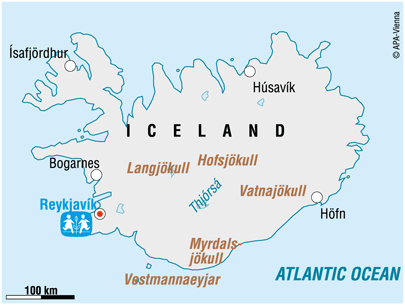
Vi er i Iceland
Some facts about Iceland
Iceland is an island state in the European North Sea, located approximately 300 km to the south-east of Greenland, 1000 km to the west of Norway, and 800 km to the north-west of Scotland. Iceland's population is 311,058 (July 2011 est.), with the country's capital city of Reykjavik being home to 198,000 (July 2009 est.). It is one of the most sparsely populated countries in Europe, with a population density of around three inhabitants per square kilometre. Around two thirds of the population is concentrated in the south-western areas near the capital.
The banking system collapses
Iceland has traditionally had one of the highest living standards in the world and an equal distribution of income. A strong welfare system has provided free universal health care and post-secondary education. Iceland has an excellent literacy rate and the life expectancy is high at 84,1 years for women and 81 years for men (2018 figures).
Due to its geographical location, historically Iceland's prosperity was mostly related to fishing – both trawling as well as the processing of fish for a variety of export products. Over time, this industry has contracted and the Icelandic economy has developed into new areas that include manufacturing and services. Tourism, especially eco-tourism, is growing in importance.
Towards the end of 2008, Iceland's banking system collapsed. The country suffered an acute financial crisis, which had serious effects for the economy of Iceland: the currency declined against the euro, and inflation and interest rates rose suddenly. In 2009, the economy shrank by 6.8 per cent and unemployment rose to 9.4 per cent. By 2010, the decline had slowed down, and the unemployment rate fell to 8.3 per cent.
The economic collapse led to political unrest, with the so-called "Kitchenware Revolution" causing the collapse of the ruling coalition government and the formation of a new government.
Situation of the children in Iceland
There are around 85,000 children under the age of 18 in Iceland. According to a UNICEF study, the children of Iceland are materially well off and have access to one of the best educational systems in Europe. Children attend school between the ages of six and 16. Pre-school education is also available and is designed to make the transition to compulsory education as easy as possible. Once secondary education is completed, students have the choice of eight institutions where they can complete their education. The transition from education to work is not always straightforward; young people between the ages of 16 and 24 suffer a higher unemployment rate, over 18 per cent do not have a job.
With the arrival of people from other countries more attention has been placed on how these children grow up. One study concluded that children of refugees found it hard to fit in and make friends. But, in general terms, Icelandic children grow up in an equal society with a lot of freedom. They are often educated about the situation of children in other areas of the world, and are encouraged to raise funds to send overseas.
SOS Children's Villages in Iceland
Prior to 1992, SOS Children's Villages in Iceland was run by volunteers. The organisation, which is based in Reykjavik, does not run any programmes in Iceland, but concentrates on raising funds for SOS Children's Villages in other parts of the world.
(available in Icelandic)